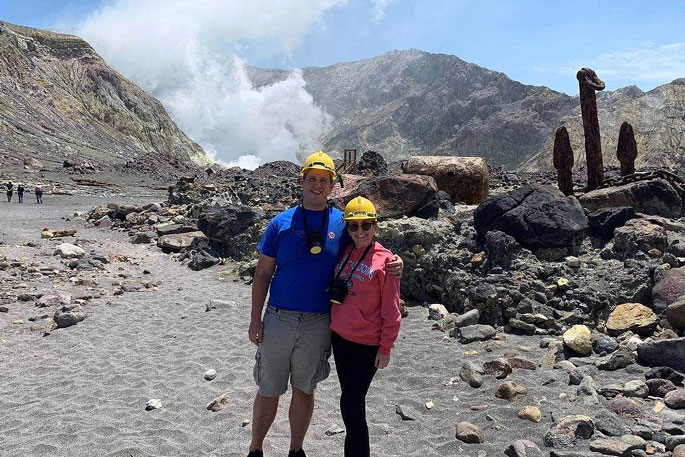A world-leading UK volcanologist says the risk of a tour group being on Whakaari when the island erupted was “hugely higher” than would normally be acceptable.
Professor Sir Stephen Sparks, an emeritus professor at the University of Bristol, said his calculations were based on figures he had been given that groups would have visited Whakaari on about 1350 hours out of the 8736 hours in a year.
The calculation included a risk of an eruption of something like 30 per cent in a year, “which is a sort of reasonable figure”, Sparks said as he gave evidence at the Whakaari White Island trial in Auckland.
For an individual tourist spending an hour and a bit on the island, there was roughly a 1 in 10,000 chance of that person being present during a highly threatening hazardous eruption, with quite a high chance that they might die or be seriously injured.
For tour groups, which may each have around 40 members, he calculated about a 5% chance that a tour group on the island might be affected. That was about a 1 in 20 chance.
“So that’s a very high societal risk,” Sparks said.
The risk for an individual of 1 in 10,000 would be “pretty well at the borderline” in the UK. That would be regarded as going from a just about tolerable risk to an unacceptable risk for an individual.
For the risk of a mass casualty event involving a tour group, the risk was “hugely higher” than what was normally regarded as an acceptable risk for a group.
In the UK there were rule of thumb thresholds for industrial facilities, where the limit was something like a 1 in 100,000 risk of a mass casualty event.
“From a societal risk point of view, it’s way into what would be regarded in the UK as an unacceptable risk.”
The trial, before Judge Evangelos Thomas, is focused on alleged health and safety failings related to having staff and tourists on the island in the lead-up to the eruption in December 2019.
Brothers Andrew, James and Peter Buttle – who own and manage the island through Whakaari Management Limited – and tour operators Tauranga Tourism Services Ltd and ID Tours New Zealand, are facing WorkSafe charges.
Forty-seven people were on the crater when it erupted, 22 of them dying from extreme burns and blast injuries.
Whakaari was “persistently active”, and during the past 200 years there was almost no evidence for any overall increase or decrease in eruptions, Sparks said.
From 1976-2000 more than 256 small explosive eruptions were recorded at Whakaari, including 45 that ejected large projectiles.
Eruptions sometimes happened in clusters, and there could be periods of many intervening years with little activity.
Even without understanding the causes of such fluctuations, it was reasonable to assume that chances of another explosion over a 10-year period was “quite high”.
There had been no single warning sign in the hours or minutes before the December 9, 2019 eruption that would have indicated an eruption was imminent, Sparks said.
It was notoriously difficult to get patterns of activity that could be used to predict eruptions like the event at Whakaari.
Witness accounts indicated two or three pulses during the eruption. Ash, steam, gas and rocks were propelled in a dark cloud to several hundred metres above the vent.
The main hazard was a pyroclastic density current base surge formed by the collapse of that eruptive mixture onto the ground, Sparks said.
The current swept down the valley within the main crater towards the sea. The surge was confined by the crater walls and flowed downhill under gravity towards the wharf.
The victims were in two groups about halfway between the vent of the explosion and the sea, along the tourist paths. “They were thus directly in the path of the surge.”
“The surge was fast moving … Witnesses described it being like a strong wind.” Some witnesses were thrown to the ground suggesting speeds of a few 10s of km per hour, Sparks said.
He estimated it would have taken about 2 minutes for the surge to inundate much of the crater, including the walking path.
The current was hot and contained volcanic ash and small rocks, and was likely to have contained some acid liquids.
The explosion was triggered when the pressure of hot pressurised water and magmatic gases trapped underground got too high. The surrounding rocks failed, enabling the material to accelerate violently and rapidly, Sparks said.
In the weeks before the explosion, elevated seismicity included episodes of seismic tremor, some ground deformation, elevated gas sulphur dioxide emissions and geysering, leading to increasing concern.
That increasing concern was shown by GNS increasing its estimate of the probability of an eruption, and the change to volcanic alert level 2 on November 18.
Overall, the probability estimate of an explosion had been increased by a factor of about 3.5 from late September to early December.
Such estimates were highly uncertain, and that uncertainty was illustrated by a large range of probability values at meetings of experts.



0 comments
Leave a Comment
You must be logged in to make a comment.